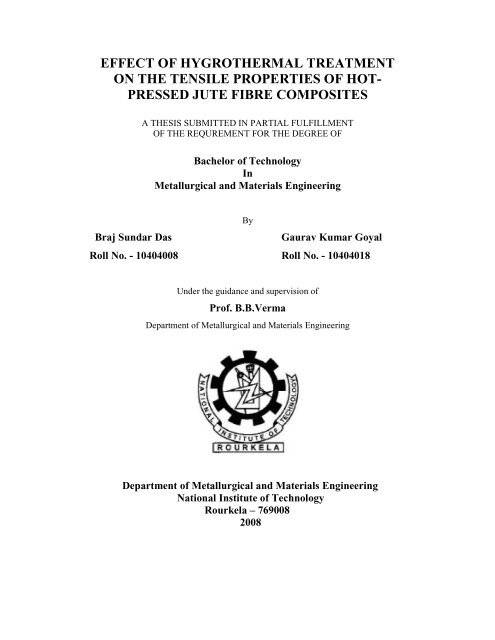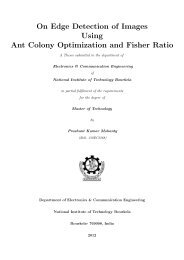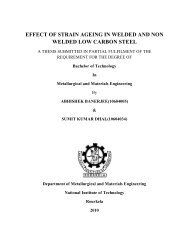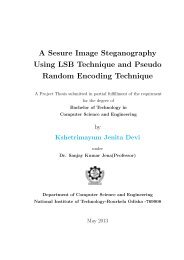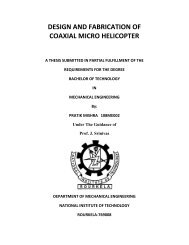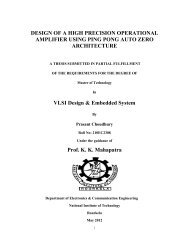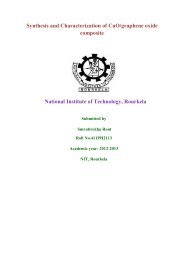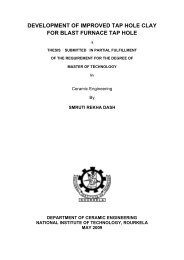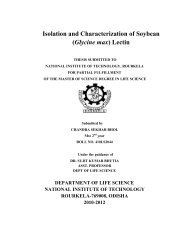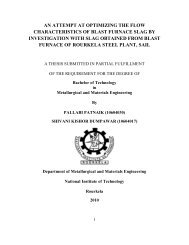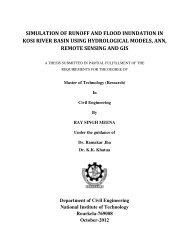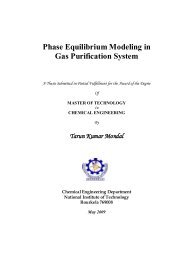Effect of hygrothermal treatment on the tensile properties - ethesis ...
Effect of hygrothermal treatment on the tensile properties - ethesis ...
Effect of hygrothermal treatment on the tensile properties - ethesis ...
You also want an ePaper? Increase the reach of your titles
YUMPU automatically turns print PDFs into web optimized ePapers that Google loves.
EFFECT OF HYGROTHERMAL TREATMENT<br />
ON THE TENSILE PROPERTIES OF HOT-<br />
PRESSED JUTE FIBRE COMPOSITES<br />
A THESIS SUBMITTED IN PARTIAL FULFILLMENT<br />
OF THE REQUREMENT FOR THE DEGREE OF<br />
Bachelor <str<strong>on</strong>g>of</str<strong>on</strong>g> Technology<br />
In<br />
Metallurgical and Materials Engineering<br />
Braj Sundar Das Gaurav Kumar Goyal<br />
Roll No. - 10404008 Roll No. - 10404018<br />
By<br />
Under <strong>the</strong> guidance and supervisi<strong>on</strong> <str<strong>on</strong>g>of</str<strong>on</strong>g><br />
Pr<str<strong>on</strong>g>of</str<strong>on</strong>g>. B.B.Verma<br />
Department <str<strong>on</strong>g>of</str<strong>on</strong>g> Metallurgical and Materials Engineering<br />
Department <str<strong>on</strong>g>of</str<strong>on</strong>g> Metallurgical and Materials Engineering<br />
Nati<strong>on</strong>al Institute <str<strong>on</strong>g>of</str<strong>on</strong>g> Technology<br />
Rourkela – 769008<br />
2008
Nati<strong>on</strong>al Institute <str<strong>on</strong>g>of</str<strong>on</strong>g> Technology<br />
Rourkela<br />
CERTIFICATE<br />
This is to certify that <strong>the</strong> <strong>the</strong>sis entitled, “<str<strong>on</strong>g>Effect</str<strong>on</strong>g> <str<strong>on</strong>g>of</str<strong>on</strong>g> Hygro<strong>the</strong>rmal <str<strong>on</strong>g>treatment</str<strong>on</strong>g> <strong>on</strong> <strong>the</strong><br />
<strong>tensile</strong> <strong>properties</strong> <str<strong>on</strong>g>of</str<strong>on</strong>g> hot-pressed jute fibre composites” submitted by Mr Braj<br />
Sundar Das and Mr Gaurav Kumar Goyal in partial fulfillment <str<strong>on</strong>g>of</str<strong>on</strong>g> <strong>the</strong> requirements<br />
for <strong>the</strong> award <str<strong>on</strong>g>of</str<strong>on</strong>g> Bachelor <str<strong>on</strong>g>of</str<strong>on</strong>g> Technology Degree in Metallurgical and Materials<br />
Engineering at <strong>the</strong> Nati<strong>on</strong>al Institute <str<strong>on</strong>g>of</str<strong>on</strong>g> Technology, Rourkela (Deemed University)<br />
is an au<strong>the</strong>ntic work carried out by her under my supervisi<strong>on</strong> and guidance.<br />
To <strong>the</strong> best <str<strong>on</strong>g>of</str<strong>on</strong>g> my knowledge, <strong>the</strong> matter embodied in <strong>the</strong> <strong>the</strong>sis has not been<br />
submitted to any o<strong>the</strong>r University / Institute for <strong>the</strong> award <str<strong>on</strong>g>of</str<strong>on</strong>g> any Degree or Diploma.<br />
Date: Pr<str<strong>on</strong>g>of</str<strong>on</strong>g>. B.B.Verma<br />
Dept. <str<strong>on</strong>g>of</str<strong>on</strong>g> Metallurgical and Materials Engg.<br />
Nati<strong>on</strong>al Institute <str<strong>on</strong>g>of</str<strong>on</strong>g> Technology<br />
Rourkela – 769008<br />
2
ACKNOWLEDGEMENT<br />
I avail this opportunity to extend my hearty indebtedness to my guide Pr<str<strong>on</strong>g>of</str<strong>on</strong>g>.<br />
B.B.Verma, Metallurgy and Materials Engineering, for his valuable guidance,<br />
c<strong>on</strong>stant encouragement and kind help at different stages for <strong>the</strong> executi<strong>on</strong> <str<strong>on</strong>g>of</str<strong>on</strong>g> this<br />
dissertati<strong>on</strong> work.<br />
I also express my sincere gratitude to Pr<str<strong>on</strong>g>of</str<strong>on</strong>g>. B.C.Ray, Metallurgy and Materials<br />
Engineering for providing laboratory facilities.<br />
I am also grateful to Pr<str<strong>on</strong>g>of</str<strong>on</strong>g>. G. S. Agrawal, Head <str<strong>on</strong>g>of</str<strong>on</strong>g> <strong>the</strong> Department, Metallurgical and<br />
Materials Engineering, for providing valuable departmental facilities. I am also<br />
grateful to Pr<str<strong>on</strong>g>of</str<strong>on</strong>g>. A.K.Panda, B. Tech Project Coordinator, for his c<strong>on</strong>stant c<strong>on</strong>cern and<br />
encouragement for executi<strong>on</strong> <str<strong>on</strong>g>of</str<strong>on</strong>g> this work.<br />
I am also grateful to Mr. Samir Pradhan, Mr. Shyamu Hembram and Mr. Rajesh<br />
Pattnaik, Technical Assistants, Metallurgical and Materials Engineering, for <strong>the</strong>ir<br />
assistance and support in carrying out <strong>the</strong> experimental porti<strong>on</strong> <str<strong>on</strong>g>of</str<strong>on</strong>g> this work.<br />
Special thanks to my friends and o<strong>the</strong>r members <str<strong>on</strong>g>of</str<strong>on</strong>g> <strong>the</strong> department for being<br />
supportive and helpful in every possible way in completing this project successfully.<br />
Braj Sundar Das<br />
Gaurav Kumar Goyal<br />
3
ABSTRACT<br />
The growing envir<strong>on</strong>ment awareness demands <strong>the</strong> use <str<strong>on</strong>g>of</str<strong>on</strong>g> nature fibres as<br />
reinforcement materials in commercial. The natural fibres however are hydrophilic in<br />
nature and <strong>the</strong>ir composites undergo envir<strong>on</strong>mental degradati<strong>on</strong> during service.<br />
Hygro<strong>the</strong>rmal c<strong>on</strong>diti<strong>on</strong>ing <strong>on</strong> as received jute fabric at different temperatures <str<strong>on</strong>g>of</str<strong>on</strong>g> hot-<br />
press have been studied in <strong>the</strong> present investigati<strong>on</strong>. These composites are usually<br />
subjected to various loading c<strong>on</strong>diti<strong>on</strong>s. Therefore, an attempt has been made to study<br />
<strong>the</strong> <strong>tensile</strong> <strong>properties</strong> <str<strong>on</strong>g>of</str<strong>on</strong>g> <strong>the</strong> composites. Fractography studies were carried out to<br />
study <strong>the</strong> fracture surface under SEM. It is noticed that <strong>the</strong> major mode <str<strong>on</strong>g>of</str<strong>on</strong>g> failure is<br />
due to fibre pullout and matrix cracking. The result from <strong>the</strong> <str<strong>on</strong>g>hygro<strong>the</strong>rmal</str<strong>on</strong>g> studies<br />
shows <strong>the</strong> decrease in strength values <str<strong>on</strong>g>of</str<strong>on</strong>g> <strong>the</strong> composites <strong>on</strong> prol<strong>on</strong>g exposure to humid<br />
envir<strong>on</strong>ment.<br />
4
CONTENTS<br />
Chapter 1 INTRODUCTION 1<br />
1.1 Introducti<strong>on</strong> 1<br />
Chapter 2 LITERATURE REVIEW 4<br />
2.1 Natural fibres and <strong>the</strong>ir chemical compositi<strong>on</strong>s 4<br />
2.2 Mechanical <strong>properties</strong> <str<strong>on</strong>g>of</str<strong>on</strong>g> natural fibres 4<br />
2.3 Jute fibres 6<br />
2.3.1 Properties <str<strong>on</strong>g>of</str<strong>on</strong>g> jute fibres 6<br />
2.3.2 Advantages <str<strong>on</strong>g>of</str<strong>on</strong>g> jute fibres 6<br />
2.3.3 Uses <str<strong>on</strong>g>of</str<strong>on</strong>g> jute fibres 6<br />
2.3.4 Limitati<strong>on</strong> <str<strong>on</strong>g>of</str<strong>on</strong>g> jute fibre composites 7<br />
2.5 Polyesters 7<br />
2.6 Tensile Properties 8<br />
2.7 Hygro<strong>the</strong>rmal <str<strong>on</strong>g>Effect</str<strong>on</strong>g>s 10<br />
Chapter 3 EXPERIMENTAL WORK 13<br />
3.1 Preparati<strong>on</strong> <str<strong>on</strong>g>of</str<strong>on</strong>g> composite 13<br />
3.2 Hygro<strong>the</strong>rmal Treatment 13<br />
3.3 Tensile testing 13<br />
Chapter 4 RESULTS and DISCUSSIONS 15<br />
4.1 Deductins from Stres-Strain Curve 17<br />
4.2 Hygro<strong>the</strong>rmal Behaviour 22<br />
4.3 Fractography by SEM analysis 23<br />
Chapter 5 CONCLUSIONS 27<br />
REFERENCES 28<br />
5
Chapter 1<br />
INTRODUCTION<br />
6
1. INTRODUCTION<br />
1.1 Introducti<strong>on</strong><br />
The most important types <str<strong>on</strong>g>of</str<strong>on</strong>g> natural fibres used in composite materials are flax, hemp,<br />
jute, kenaf, and sisal due to <strong>the</strong>ir <strong>properties</strong> and availability. Jute is an important bast<br />
fibre with a number <str<strong>on</strong>g>of</str<strong>on</strong>g> advantages. Jute has high specific <strong>properties</strong>, low density, less<br />
abrasive behaviour to <strong>the</strong> processing equipment, good dimensi<strong>on</strong>al stability and<br />
harmlessness. Jute textile is a low cost eco-friendly product and is abundantly<br />
available, easy to transport and has superior drapability and moisture retenti<strong>on</strong><br />
capacity. It is widely being used as a natural choice for plant mulching and rural road<br />
pavement c<strong>on</strong>structi<strong>on</strong>. The biodegradable and low priced jute products merge with<br />
<strong>the</strong> soil after using providing nourishment to <strong>the</strong> soil. Being made <str<strong>on</strong>g>of</str<strong>on</strong>g> cellulose, <strong>on</strong><br />
combusti<strong>on</strong>, jute does not generate toxic gases.<br />
Due to jute’s low density combined with relatively stiff and str<strong>on</strong>g behaviour, <strong>the</strong><br />
specific <strong>properties</strong> <str<strong>on</strong>g>of</str<strong>on</strong>g> jute fibre can compare to those <str<strong>on</strong>g>of</str<strong>on</strong>g> glass and some o<strong>the</strong>r fibres.<br />
Table 1.1: Properties <str<strong>on</strong>g>of</str<strong>on</strong>g> jute fibre in comparis<strong>on</strong> with o<strong>the</strong>r fibres<br />
The natural fibres can be used to reinforce both <strong>the</strong>rmosetting and <strong>the</strong>rmoplastic<br />
matrices.<br />
Thermosetting resins, such as epoxy, polyester, polyurethane, phenolic, etc. are<br />
comm<strong>on</strong>ly used today in natural fibre composites, in which composites requiring<br />
higher performance applicati<strong>on</strong>s. They provide sufficient mechanical <strong>properties</strong>, in<br />
particular stiffness and strength, at acceptably low price levels. Compared to<br />
7
compounds based <strong>on</strong> <strong>the</strong>rmoplastic polymers, <strong>the</strong>rmoset compounds have a superior<br />
<strong>the</strong>rmal stability and lower water absorpti<strong>on</strong>. However, in <strong>the</strong> case <str<strong>on</strong>g>of</str<strong>on</strong>g> <strong>the</strong> demand for<br />
improved recycling and in combinati<strong>on</strong> with new l<strong>on</strong>g fibre reinforced <strong>the</strong>rmoplastic<br />
(LFT) processing, <strong>the</strong>rmoplastic polymers have been expected to substitute <strong>the</strong><br />
<strong>the</strong>rmoset polymers.<br />
C<strong>on</strong>sidering <strong>the</strong> ecological aspects <str<strong>on</strong>g>of</str<strong>on</strong>g> material selecti<strong>on</strong>, replacing syn<strong>the</strong>tic fibres by<br />
natural <strong>on</strong>es is <strong>on</strong>ly a first step. Restricting <strong>the</strong> emissi<strong>on</strong> <str<strong>on</strong>g>of</str<strong>on</strong>g> green house effect causing<br />
gases such as CO2 into <strong>the</strong> atmosphere and an increasing awareness <str<strong>on</strong>g>of</str<strong>on</strong>g> <strong>the</strong> finiteness<br />
<str<strong>on</strong>g>of</str<strong>on</strong>g> fossil energy resources are leading to developing new materials that are entirely<br />
based <strong>on</strong> renewable resources.<br />
The natural fibre composites can be very cost effective material for following<br />
applicati<strong>on</strong>s:<br />
- Building and c<strong>on</strong>structi<strong>on</strong> industry: panels for partiti<strong>on</strong> and false ceiling, partiti<strong>on</strong><br />
boards, wall, floor, window and door frames, ro<str<strong>on</strong>g>of</str<strong>on</strong>g> tiles, mobile or pre-fabricated<br />
buildings which can be used in times <str<strong>on</strong>g>of</str<strong>on</strong>g> natural calamities such as floods, cycl<strong>on</strong>es,<br />
earthquakes, etc.<br />
- Storage devices: post-boxes, grain storage silos, bio-gas c<strong>on</strong>tainers, etc.<br />
- Furniture: chair, table, shower, bath units, etc.<br />
- Electric devices: electrical appliances, pipes, etc.<br />
- Everyday applicati<strong>on</strong>s: lampshades, suitcases, helmets, etc.<br />
- Transportati<strong>on</strong>: automobile and railway coach interior, boat, etc.<br />
- Toys<br />
The reas<strong>on</strong>s for <strong>the</strong> applicati<strong>on</strong> <str<strong>on</strong>g>of</str<strong>on</strong>g> natural fibres in <strong>the</strong> automotive industry include [1,<br />
2]:<br />
- Low density: which may lead to a weight reducti<strong>on</strong> <str<strong>on</strong>g>of</str<strong>on</strong>g> 10 to 30%.<br />
- Acceptable mechanical <strong>properties</strong>, good acoustic <strong>properties</strong>.<br />
- Favourable processing <strong>properties</strong>, for instance low wear <strong>on</strong> tools, etc.<br />
- Opti<strong>on</strong>s for new producti<strong>on</strong> technologies and materials.<br />
- Favourable accident performance, high stability, less splintering.<br />
- Favourable ecobalance for part producti<strong>on</strong>.<br />
- Favourable ecobalance during vehicle operati<strong>on</strong> due to weight savings.<br />
- Occupati<strong>on</strong>al health benefits compared to glass fibres during producti<strong>on</strong>.<br />
- No <str<strong>on</strong>g>of</str<strong>on</strong>g>f-gassing <str<strong>on</strong>g>of</str<strong>on</strong>g> toxic compounds (in c<strong>on</strong>trast to phenol resin b<strong>on</strong>ded wood and<br />
recycled cott<strong>on</strong> fibre parts).<br />
8
- Reduced fogging behaviour.<br />
- Price advantages both for <strong>the</strong> fibres and <strong>the</strong> applied technologies.<br />
Besides <strong>the</strong> advantages menti<strong>on</strong>ed above, <strong>the</strong> natural fibre composites possess also<br />
some disadvantages. The main disadvantage is <strong>the</strong> poor compatibility between a<br />
hydrophobic polymer matrix and <strong>the</strong> hydrophilic fibres. This leads to <strong>the</strong> formati<strong>on</strong> <str<strong>on</strong>g>of</str<strong>on</strong>g><br />
weak interfaces, which result in poor mechanical <strong>properties</strong> <str<strong>on</strong>g>of</str<strong>on</strong>g> <strong>the</strong> composites. O<strong>the</strong>r<br />
important disadvantages <str<strong>on</strong>g>of</str<strong>on</strong>g> <strong>the</strong> natural fibre composites are <strong>the</strong> high sensitivity <str<strong>on</strong>g>of</str<strong>on</strong>g><br />
natural fibres towards water and <strong>the</strong> relatively poor <strong>the</strong>rmal stability. Water<br />
absorpti<strong>on</strong> <strong>on</strong> composites is an issue to be c<strong>on</strong>sidered since <strong>the</strong> water absorbed by <strong>the</strong><br />
fibres in <strong>the</strong> composite could lead to swelling and dimensi<strong>on</strong>al instability and to a loss<br />
<str<strong>on</strong>g>of</str<strong>on</strong>g> mechanical <strong>properties</strong> due to<br />
Fig.1.1. Plant fibre applicati<strong>on</strong>s in <strong>the</strong> current Mercedes-Benz R-class [2]<br />
<strong>the</strong> degradati<strong>on</strong> <str<strong>on</strong>g>of</str<strong>on</strong>g> <strong>the</strong> fibres and <strong>the</strong> interface between <strong>the</strong> fibre and matrix [3, 4, 5, 6,<br />
7, 8].<br />
9
Chapter 2<br />
LITERATURE<br />
REVIEW<br />
10
2. LITERATURE REVIEW<br />
2.1. Natural fibres and <strong>the</strong>ir chemical compositi<strong>on</strong>s<br />
Climatic c<strong>on</strong>diti<strong>on</strong>s, age and <strong>the</strong> digesti<strong>on</strong> process influences not <strong>on</strong>ly <strong>the</strong> structure <str<strong>on</strong>g>of</str<strong>on</strong>g><br />
fibres but also <strong>the</strong> chemical compositi<strong>on</strong>. Comp<strong>on</strong>ent mean values <str<strong>on</strong>g>of</str<strong>on</strong>g> plant-fibres are<br />
shown in Table 2.1. With <strong>the</strong> excepti<strong>on</strong> <str<strong>on</strong>g>of</str<strong>on</strong>g> cott<strong>on</strong>, <strong>the</strong> comp<strong>on</strong>ents <str<strong>on</strong>g>of</str<strong>on</strong>g> natural fibres are<br />
cellulose, hemi-cellulose, lignin, pectin, waxes and water soluble substances, with<br />
cellulose, hemi-cellulose and lignin as <strong>the</strong> basic comp<strong>on</strong>ents with regard to <strong>the</strong><br />
physical <strong>properties</strong> <str<strong>on</strong>g>of</str<strong>on</strong>g> <strong>the</strong> fibres.<br />
Table 2.1: Compositi<strong>on</strong> <str<strong>on</strong>g>of</str<strong>on</strong>g> different cellulose based natural fibres<br />
2.2. Mechanical <strong>properties</strong> <str<strong>on</strong>g>of</str<strong>on</strong>g> natural fibres<br />
Natural fibres are in general suitable to reinforce plastics (<strong>the</strong>rmosets as well as<br />
<strong>the</strong>rmoplastics) due to <strong>the</strong>ir relative high strength and stiffness and low density (Table<br />
3). The characteristic values for flax and s<str<strong>on</strong>g>of</str<strong>on</strong>g>t-wood-kraft-fibres reach levels close to<br />
<strong>the</strong> values for glass-fibres, types E (“E” because <str<strong>on</strong>g>of</str<strong>on</strong>g> <strong>the</strong>ir early use in electr<strong>on</strong>ic<br />
applicati<strong>on</strong>s and today <strong>the</strong> most typically used glassfibres reinforcing plastics in n<strong>on</strong>-<br />
aggressive media). Never<strong>the</strong>less and also obvious in(Table 3), <strong>the</strong> range <str<strong>on</strong>g>of</str<strong>on</strong>g> <strong>the</strong><br />
characteristic values, as <strong>on</strong>e <str<strong>on</strong>g>of</str<strong>on</strong>g> <strong>the</strong> drawbacks for all natural products, is remarkably<br />
higher than those <str<strong>on</strong>g>of</str<strong>on</strong>g> glass-fibres, which can be explained by differences in fibre<br />
structure due to <strong>the</strong> overall envir<strong>on</strong>mental c<strong>on</strong>diti<strong>on</strong>s during growth. Natural fibres<br />
can be processed in different ways to yield reinforcing elements having different<br />
11
mechanical <strong>properties</strong>. The elastic modulus <str<strong>on</strong>g>of</str<strong>on</strong>g> bulk natural fibres such as wood is<br />
about 10 GPa. Cellulose fibre with<br />
moduli up to 40 GPa can be separated from wood, for instance, by chemical pulping<br />
processes.Such fibres can be fur<strong>the</strong>r subdivided by hydrolysis followed by mechanical<br />
disintegrati<strong>on</strong> into micr<str<strong>on</strong>g>of</str<strong>on</strong>g>ibrils with an elastic modulus <str<strong>on</strong>g>of</str<strong>on</strong>g> 70 GPa. Theoretical<br />
calculati<strong>on</strong>s <str<strong>on</strong>g>of</str<strong>on</strong>g> <strong>the</strong> elastic moduli <str<strong>on</strong>g>of</str<strong>on</strong>g> cellulose chains have given values <str<strong>on</strong>g>of</str<strong>on</strong>g> up to 250<br />
GPa, however, <strong>the</strong>re is no technology available to separate <strong>the</strong>se from micr<str<strong>on</strong>g>of</str<strong>on</strong>g>ibrils.<br />
Table 2.2: Mechanical <strong>properties</strong> <str<strong>on</strong>g>of</str<strong>on</strong>g> natural fibres as compared to c<strong>on</strong>venti<strong>on</strong>al<br />
reinforcing fibres<br />
As in <strong>the</strong> case with glass-fibres, <strong>the</strong> <strong>tensile</strong> strength <str<strong>on</strong>g>of</str<strong>on</strong>g> natural fibres also depends <strong>on</strong><br />
<strong>the</strong> test length <str<strong>on</strong>g>of</str<strong>on</strong>g> <strong>the</strong> specimens which is <str<strong>on</strong>g>of</str<strong>on</strong>g> main importance regarding reinforcing<br />
efficiency. The actual <strong>tensile</strong> strength <str<strong>on</strong>g>of</str<strong>on</strong>g> a single fibre is typically given for a test<br />
length <str<strong>on</strong>g>of</str<strong>on</strong>g> zero as in <strong>the</strong> case for glassfibres. The <strong>tensile</strong> strength <str<strong>on</strong>g>of</str<strong>on</strong>g> flax-fibres is<br />
significantly more dependent <strong>on</strong> <strong>the</strong> length <str<strong>on</strong>g>of</str<strong>on</strong>g> <strong>the</strong> fibre than for <strong>the</strong> case <str<strong>on</strong>g>of</str<strong>on</strong>g> glass-<br />
fibres. Compared to this, <strong>the</strong> <strong>tensile</strong> strength <str<strong>on</strong>g>of</str<strong>on</strong>g> pineapple-fibres is less dependent <strong>on</strong><br />
<strong>the</strong> length, while <strong>the</strong> scatter <str<strong>on</strong>g>of</str<strong>on</strong>g> <strong>the</strong> measured values for both is located mainly in <strong>the</strong><br />
range <str<strong>on</strong>g>of</str<strong>on</strong>g> <strong>the</strong> standard deviati<strong>on</strong>. This dependence, strength vs. test length, could be<br />
12
seen as degree or <strong>the</strong> homogenity or amounts <str<strong>on</strong>g>of</str<strong>on</strong>g> defects <str<strong>on</strong>g>of</str<strong>on</strong>g> a fibre or a material in<br />
general. Hydrophilic nature is a major problem for all cellulose-fibres if used as<br />
reinforcement in plastics.<br />
The moisture c<strong>on</strong>tent <str<strong>on</strong>g>of</str<strong>on</strong>g> <strong>the</strong> fibres, dependent <strong>on</strong> c<strong>on</strong>tent <str<strong>on</strong>g>of</str<strong>on</strong>g> n<strong>on</strong>-crystalline parts and<br />
void<br />
c<strong>on</strong>tent <str<strong>on</strong>g>of</str<strong>on</strong>g> <strong>the</strong> fibre, amounts up to 10 wt. % under standard c<strong>on</strong>diti<strong>on</strong>s. The<br />
hydrophilic nature <str<strong>on</strong>g>of</str<strong>on</strong>g> natural fibres influences <strong>the</strong> overall mechanical <strong>properties</strong> as<br />
well as o<strong>the</strong>r physical <strong>properties</strong> <str<strong>on</strong>g>of</str<strong>on</strong>g> <strong>the</strong> fibre itself.<br />
2.2. Jute fibres<br />
2.2.1. Properties <str<strong>on</strong>g>of</str<strong>on</strong>g> jute fibres<br />
The need for using jute fibres in place <str<strong>on</strong>g>of</str<strong>on</strong>g> <strong>the</strong> traditi<strong>on</strong>al glass fibre partly or fully as<br />
reinforcing agents in composites stems from its:<br />
• Lower specific gravity (1.29) and higher specific modulus (40 GPa) <str<strong>on</strong>g>of</str<strong>on</strong>g> jute<br />
compared<br />
with those <str<strong>on</strong>g>of</str<strong>on</strong>g> glass (2.5 & 30 GPa respectively),<br />
• Jute fibre is 100% bio-degradable.<br />
• It has high <strong>tensile</strong> strength, low extensibility, and ensures better breathability <str<strong>on</strong>g>of</str<strong>on</strong>g><br />
fabrics,<br />
• It has good insulating and antistatic <strong>properties</strong>, as well as having low <strong>the</strong>rmal<br />
c<strong>on</strong>ductivity.<br />
2.2.2. Advantages <str<strong>on</strong>g>of</str<strong>on</strong>g> jute fibres<br />
Apart from much lower cost and renewable nature <str<strong>on</strong>g>of</str<strong>on</strong>g> jute, much lower energy<br />
requirement for <strong>the</strong> producti<strong>on</strong> <str<strong>on</strong>g>of</str<strong>on</strong>g> jute (<strong>on</strong>ly 2% <str<strong>on</strong>g>of</str<strong>on</strong>g> that for glass) makes it attractive as<br />
a reinforcing fibre in composites. Jute fibre is recyclable and thus envir<strong>on</strong>ment<br />
friendly starting from <strong>the</strong> seed to expired fibre, as <strong>the</strong> expired fibres can be recycled<br />
more than <strong>on</strong>ce. Jute fibres are easily available and <strong>the</strong>se are envir<strong>on</strong>ment friendly.<br />
2.2.3. Uses <str<strong>on</strong>g>of</str<strong>on</strong>g> jute fibres<br />
Jute has entered various diversified sectors, where natural fibres are gradually<br />
becoming better substituti<strong>on</strong>. Am<strong>on</strong>g <strong>the</strong>se industries are paper, celluloid products<br />
(films), n<strong>on</strong>woven textiles (for car interiors and o<strong>the</strong>r uses), composites (pseudo-<br />
13
wood), and geotextiles. The jute composites may be used in everyday applicati<strong>on</strong>s<br />
such as lampshades, suitcases, paperweights, helmets, shower and bath units. They are<br />
also used for covers <str<strong>on</strong>g>of</str<strong>on</strong>g> electrical appliances, pipes, post-boxes, ro<str<strong>on</strong>g>of</str<strong>on</strong>g> tiles, grain<br />
storage silos, panels for partiti<strong>on</strong> & false ceilings, bio-gas c<strong>on</strong>tainers, and in <strong>the</strong><br />
c<strong>on</strong>structi<strong>on</strong> <str<strong>on</strong>g>of</str<strong>on</strong>g> low cost,<br />
mobile or pre-fabricated buildings which can be used in times <str<strong>on</strong>g>of</str<strong>on</strong>g> natural calamities<br />
such as floods, cycl<strong>on</strong>es, earthquakes, etc.<br />
2.2.4. Limitati<strong>on</strong> <str<strong>on</strong>g>of</str<strong>on</strong>g> jute fibre composites<br />
Unfortunately, all mechanical and o<strong>the</strong>r physical <strong>properties</strong> <str<strong>on</strong>g>of</str<strong>on</strong>g> natural fibres are<br />
influenced by <strong>the</strong>ir growing c<strong>on</strong>diti<strong>on</strong>s, fibre processing technique and, as for o<strong>the</strong>r<br />
fibre types, by <strong>the</strong> fineness <str<strong>on</strong>g>of</str<strong>on</strong>g> <strong>the</strong> fibre and sample test-length. Although, as with most<br />
<str<strong>on</strong>g>of</str<strong>on</strong>g> <strong>the</strong> o<strong>the</strong>r plant-based natural fibres, cellulose forms <strong>the</strong> main structural comp<strong>on</strong>ent<br />
<str<strong>on</strong>g>of</str<strong>on</strong>g> jute, <strong>the</strong> n<strong>on</strong>-cellulosic comp<strong>on</strong>ents e.g., lignin and hemicellulose, also play an<br />
important part in determining <strong>the</strong> characteristic <strong>properties</strong> <str<strong>on</strong>g>of</str<strong>on</strong>g> <strong>the</strong> fibres.<br />
There is, however, a major drawback associated with <strong>the</strong> applicati<strong>on</strong> <str<strong>on</strong>g>of</str<strong>on</strong>g> jute fibres for<br />
reinforcement <str<strong>on</strong>g>of</str<strong>on</strong>g> resin matrices. Due to presence <str<strong>on</strong>g>of</str<strong>on</strong>g> hydroxy and o<strong>the</strong>r polar groups in<br />
various c<strong>on</strong>stituents <str<strong>on</strong>g>of</str<strong>on</strong>g> jute fibre, <strong>the</strong> moisture uptake is high (approx. 12.5% at 65%<br />
relative humidity & 20 o C) by dry fibre and 14.6% by wet fibre. All this leads to (i)<br />
poor wettability with resin and (ii) weak interfacial b<strong>on</strong>ding between jute fibre and <strong>the</strong><br />
relatively more hydrophobic matrices. Envir<strong>on</strong>mental performance <str<strong>on</strong>g>of</str<strong>on</strong>g> such<br />
composites is generally poor due to delaminati<strong>on</strong> under humid c<strong>on</strong>diti<strong>on</strong>s. With<br />
increase in relative humidity upto 70%, <strong>the</strong> tenacity and Young’s modulus <str<strong>on</strong>g>of</str<strong>on</strong>g> jute<br />
increases but bey<strong>on</strong>d 70%, a decrease is observed.<br />
2.5. Polyester<br />
Cure at room or elevated temperature. It has good chemical resistance.<br />
Limitati<strong>on</strong>s:- emissi<strong>on</strong> <str<strong>on</strong>g>of</str<strong>on</strong>g> styrene, shrinkage <strong>on</strong> curing (7-10%)<br />
The term polyester covers a very large chemical family <str<strong>on</strong>g>of</str<strong>on</strong>g> which “unsaturated resins”<br />
covering orthophthalic, isophthalic, vinyl esters and blends form <strong>the</strong> largest single<br />
group <str<strong>on</strong>g>of</str<strong>on</strong>g> fibre reinforced <strong>the</strong>rmosets. They are usually manufactured by reacting<br />
toge<strong>the</strong>r dihydric alcohols (glycols) and dibasic organic acid, ei<strong>the</strong>r or both <str<strong>on</strong>g>of</str<strong>on</strong>g> which<br />
c<strong>on</strong>tain a double-b<strong>on</strong>ded pair <str<strong>on</strong>g>of</str<strong>on</strong>g> C atoms. By eliminati<strong>on</strong> <str<strong>on</strong>g>of</str<strong>on</strong>g> water between <strong>the</strong> acids<br />
and glycols, ester linkages are formed, producing a l<strong>on</strong>g chain molecule comprising<br />
14
alternate acid and glycol units. The polymer chain is dissolved in a reactive organic<br />
solvent, usually styrene m<strong>on</strong>omer or methyl methacrylate, vinyl toluene or alpha-<br />
methyl styrene. With heat and a chemically activated free radical initiati<strong>on</strong>, <strong>the</strong><br />
polyester and <strong>the</strong> reactive diluents crosslink to form 3-D n<strong>on</strong> melting network. The<br />
reacti<strong>on</strong> is in a kettle at 170-200 0 C with comp<strong>on</strong>ents in equal molecular ratio and<br />
water eliminated.<br />
Polyester resins are cured by organic peroxides which initiate a free radical<br />
copolymerizati<strong>on</strong> reacti<strong>on</strong>. This can occur at room temperature, under heat (60-90 0 C)<br />
or by UV or visible light radiati<strong>on</strong>. The catalyst system comprises organic peroxides<br />
(initiators) which are activated by accelerators or promoters. The resin begins to cure<br />
as so<strong>on</strong> as <strong>the</strong> initiator is added, <strong>the</strong> speed <str<strong>on</strong>g>of</str<strong>on</strong>g> reactivity depending <strong>on</strong> <strong>the</strong> temperature,<br />
resin and catalyst reactivity.<br />
2.6. Tensile Properties<br />
Fig. 2.1: Tensile Properties <str<strong>on</strong>g>of</str<strong>on</strong>g> jute fibre, fabric and composites<br />
Fig. 1 shows <strong>the</strong> stress–strain diagram for jute fibre and jute fabric. Jute fibre exhibits<br />
stiffer characteristics as compared to jute fabric. This is due more to initial stretching<br />
<str<strong>on</strong>g>of</str<strong>on</strong>g> <strong>the</strong> fabric than <strong>the</strong> nature <str<strong>on</strong>g>of</str<strong>on</strong>g> <strong>the</strong> fibre. For both fibre and fabric, <strong>the</strong> curves are<br />
initially horiz<strong>on</strong>tal due to <strong>the</strong> stretching effect caused by removing slack from <strong>the</strong><br />
system. Strands in <strong>the</strong> fabric break at different times as each fibre can stretch<br />
independently and break individually when reaching <strong>the</strong>ir breaking stress. The failure<br />
mode is by progressive breaking <str<strong>on</strong>g>of</str<strong>on</strong>g> <strong>the</strong> fibres. It has been observed that strands in <strong>the</strong><br />
15
fabric begin to fail from <strong>the</strong> centre <str<strong>on</strong>g>of</str<strong>on</strong>g> <strong>the</strong> fabric and propagate width-wise <strong>on</strong> ei<strong>the</strong>r<br />
side. The ultimate <strong>tensile</strong> strength and <strong>the</strong> tangent modulus <str<strong>on</strong>g>of</str<strong>on</strong>g> elasticity after initial<br />
stretching <str<strong>on</strong>g>of</str<strong>on</strong>g> <strong>the</strong> ‘as received’ jute fibre is found to be 120 MPa and 3.75 GPa;<br />
corresp<strong>on</strong>ding values for jute fabric are 85 MPa and 0.8 GPa. The variati<strong>on</strong> in <strong>the</strong><br />
values <str<strong>on</strong>g>of</str<strong>on</strong>g> strengths may be due to: (i) <strong>the</strong> assumpti<strong>on</strong> that <strong>the</strong> cross-secti<strong>on</strong>al area <str<strong>on</strong>g>of</str<strong>on</strong>g><br />
each yarn is circular, (ii) <strong>the</strong> difference in <strong>the</strong> strength <str<strong>on</strong>g>of</str<strong>on</strong>g> individual fibres in <strong>the</strong> fabric<br />
arising out <str<strong>on</strong>g>of</str<strong>on</strong>g> process defects.<br />
The <strong>tensile</strong> strength <str<strong>on</strong>g>of</str<strong>on</strong>g> a composite material is mainly dependent <strong>on</strong> <strong>the</strong> strength and<br />
modulus <str<strong>on</strong>g>of</str<strong>on</strong>g> fibres, <strong>the</strong> strength and chemical stability <str<strong>on</strong>g>of</str<strong>on</strong>g> <strong>the</strong> matrix and <strong>the</strong><br />
effectiveness<br />
<str<strong>on</strong>g>of</str<strong>on</strong>g> <strong>the</strong> b<strong>on</strong>ding strength between matrix and fibres in transferring stress across <strong>the</strong><br />
interface [10]. Fig. 2 shows <strong>the</strong> stress–strain diagram for four jute laminates and a<br />
polyester resin. The initial linear porti<strong>on</strong> <str<strong>on</strong>g>of</str<strong>on</strong>g> <strong>the</strong> jute laminate curves shows <strong>the</strong> elastic<br />
behaviour <str<strong>on</strong>g>of</str<strong>on</strong>g> <strong>the</strong> composite. The deviati<strong>on</strong> from linearity is an indicati<strong>on</strong> <str<strong>on</strong>g>of</str<strong>on</strong>g> <strong>the</strong><br />
beginning<br />
<str<strong>on</strong>g>of</str<strong>on</strong>g> initial matrix cracking, and <strong>the</strong> first major change in slope in <strong>the</strong> curve is <strong>the</strong> sign<br />
<str<strong>on</strong>g>of</str<strong>on</strong>g> a major crack in <strong>the</strong> matrix or <strong>the</strong> beginning <str<strong>on</strong>g>of</str<strong>on</strong>g> fibre failure. The first fibre failure<br />
occurs at a stress level <str<strong>on</strong>g>of</str<strong>on</strong>g> 26 MPa (approx.) and <strong>the</strong> corresp<strong>on</strong>ding resin stress is 5.5<br />
MPa for <strong>the</strong> same amount <str<strong>on</strong>g>of</str<strong>on</strong>g> strain. The rest <str<strong>on</strong>g>of</str<strong>on</strong>g> <strong>the</strong> drops in <strong>the</strong> curves are indicati<strong>on</strong>s<br />
<str<strong>on</strong>g>of</str<strong>on</strong>g> progressive failure <str<strong>on</strong>g>of</str<strong>on</strong>g> fibres as <strong>the</strong> applied load increases, and <strong>the</strong> end <str<strong>on</strong>g>of</str<strong>on</strong>g> <strong>the</strong> curve<br />
represents <strong>the</strong> ultimate stress which is due to fibre fracture and may be fibre pull-out.<br />
However, <strong>the</strong> failure mode exhibits breakage and little pull-out <str<strong>on</strong>g>of</str<strong>on</strong>g> fibres. The average<br />
values <str<strong>on</strong>g>of</str<strong>on</strong>g> ultimate <strong>tensile</strong> strength, initial tangent modulus and Poiss<strong>on</strong>’s ratio for<br />
<strong>the</strong>se composites are 60 MPa, 7 GPa and 0.257, respectively, and corresp<strong>on</strong>ding<br />
values for polyester resin are 12.1 MPa, 1.4 GPa and 0.38. The values obtained by <strong>the</strong><br />
rule <str<strong>on</strong>g>of</str<strong>on</strong>g> mixture are 63 MPa and 1.12 GPa. The difference in <strong>the</strong> initial tangent<br />
modulus obtained from experiment and rule <str<strong>on</strong>g>of</str<strong>on</strong>g> mixture is due to initial stretching and<br />
<strong>the</strong> nature <str<strong>on</strong>g>of</str<strong>on</strong>g> <strong>the</strong> fibres.<br />
16
2.7. Hygro<strong>the</strong>rmal <str<strong>on</strong>g>Effect</str<strong>on</strong>g>s:-<br />
Fig. 2.2: Percentage moisture pickup vs square root <str<strong>on</strong>g>of</str<strong>on</strong>g> c<strong>on</strong>diti<strong>on</strong>ing time<br />
The amount <str<strong>on</strong>g>of</str<strong>on</strong>g> moisture absorpti<strong>on</strong> by FRP composites in humid c<strong>on</strong>diti<strong>on</strong>s is a<br />
functi<strong>on</strong> <str<strong>on</strong>g>of</str<strong>on</strong>g> time and temperature [7]. Fig. 1 is representative <str<strong>on</strong>g>of</str<strong>on</strong>g> <strong>the</strong> moisture<br />
absorpti<strong>on</strong> kinetics in FRP composites. The first regi<strong>on</strong> shows a marked linearity<br />
indicating Fickian absorpti<strong>on</strong>, where <strong>the</strong> moisture is absorbed according to Fick’s<br />
sec<strong>on</strong>d law <str<strong>on</strong>g>of</str<strong>on</strong>g> diffusi<strong>on</strong>. Following this a saturati<strong>on</strong> level is achieved, which is<br />
indicated by <strong>the</strong> horiz<strong>on</strong>tal regi<strong>on</strong> <str<strong>on</strong>g>of</str<strong>on</strong>g> <strong>the</strong> curve. The amount <str<strong>on</strong>g>of</str<strong>on</strong>g> moisture absorbed<br />
depends <strong>on</strong> <strong>the</strong> partial pressure <str<strong>on</strong>g>of</str<strong>on</strong>g> <strong>the</strong> moisture in <strong>the</strong> surrounding and <strong>the</strong> moisture in<br />
<strong>the</strong> composite. Once a temporary equilibrium is reached, a saturati<strong>on</strong> regi<strong>on</strong> is<br />
attained. Prol<strong>on</strong>ged exposure to <str<strong>on</strong>g>hygro<strong>the</strong>rmal</str<strong>on</strong>g> envir<strong>on</strong>ment results in <strong>the</strong> third stage <str<strong>on</strong>g>of</str<strong>on</strong>g><br />
<strong>the</strong> curve clearly indicating n<strong>on</strong>-Fickian moisture absorpti<strong>on</strong> kinetics. Fickian and<br />
n<strong>on</strong>-Fickian moisture absorpti<strong>on</strong> kinetics have been explained by Li-R<strong>on</strong>g Bao and<br />
coworkers [8]. The diffusi<strong>on</strong> <strong>properties</strong> <str<strong>on</strong>g>of</str<strong>on</strong>g> <strong>the</strong> interface may be different from those <str<strong>on</strong>g>of</str<strong>on</strong>g><br />
<strong>the</strong> bulk matrix probably due to <strong>the</strong> formati<strong>on</strong> <str<strong>on</strong>g>of</str<strong>on</strong>g> a boundary layer. When <strong>the</strong> fracti<strong>on</strong><br />
17
<str<strong>on</strong>g>of</str<strong>on</strong>g> matrix in <strong>the</strong> interface regi<strong>on</strong> is significant, moisture transport may be c<strong>on</strong>siderably<br />
affected.<br />
Surface absorpti<strong>on</strong> and diffusi<strong>on</strong> through <strong>the</strong> matrix is <strong>the</strong> primary mechanism for<br />
moisture pick up in most <str<strong>on</strong>g>of</str<strong>on</strong>g> <strong>the</strong> well fabricated composite materials during <strong>the</strong> initial<br />
period <str<strong>on</strong>g>of</str<strong>on</strong>g> exposure [10]. The composite materials c<strong>on</strong>tain cracks and micro voids in<br />
<strong>the</strong> matrix. These are formed during <strong>the</strong> polymerizati<strong>on</strong> <str<strong>on</strong>g>of</str<strong>on</strong>g> <strong>the</strong> matrix. The free<br />
polymer chains get entangled with each o<strong>the</strong>r and create <strong>the</strong>se micro voids in <strong>the</strong><br />
matrix [11]. These micro voids are <strong>the</strong> major sites for <strong>the</strong> moisture pick ups in <strong>the</strong><br />
composite materials, especially during <strong>the</strong> initial period. Gradually when <strong>the</strong> moisture<br />
diffuses inside <strong>the</strong> matrix, it starts to interact chemically with <strong>the</strong> polymer.<br />
This is marked by a chemical phenomen<strong>on</strong> called matrix hydrolysis [7]. When this<br />
mechanism is spread through out <strong>the</strong> composite in a wider range, <strong>the</strong>n <strong>the</strong> over all<br />
chemistry <str<strong>on</strong>g>of</str<strong>on</strong>g> <strong>the</strong> polymer is significantly affected. Thus <strong>the</strong> adhesi<strong>on</strong> between <strong>the</strong><br />
fiber and <strong>the</strong> matrix is compromised stupendously, causing <strong>the</strong> de-b<strong>on</strong>ding at <strong>the</strong> fiber<br />
matrix interface [12]. Finally, <strong>the</strong> composite fails completely, when its c<strong>on</strong>stituents<br />
separates out from each o<strong>the</strong>r. In o<strong>the</strong>r words, <strong>the</strong> composite fails when <strong>the</strong> interface<br />
between <strong>the</strong> fiber and <strong>the</strong> matrix collapses completely. Thus <strong>the</strong> failure <str<strong>on</strong>g>of</str<strong>on</strong>g> <strong>the</strong><br />
composite deals with surface chemistry <str<strong>on</strong>g>of</str<strong>on</strong>g> <strong>the</strong> fiber-matrix interface due to physical,<br />
chemical and physico-chemical changes <str<strong>on</strong>g>of</str<strong>on</strong>g> <strong>the</strong> matrix during its service c<strong>on</strong>diti<strong>on</strong>s.<br />
The exposure <str<strong>on</strong>g>of</str<strong>on</strong>g> composite at higher temperature enhances <strong>the</strong> matrix cracking due to<br />
mismatch in <strong>the</strong>rmal strain. There is also a possibility <str<strong>on</strong>g>of</str<strong>on</strong>g> polymerizati<strong>on</strong> in <strong>the</strong>m. The<br />
crosslinking during <strong>the</strong> polymerizati<strong>on</strong> process results in an increased number <str<strong>on</strong>g>of</str<strong>on</strong>g><br />
micro voids in <strong>the</strong> composites. C<strong>on</strong>sequently, <strong>the</strong>re exists more sites for moisture pick<br />
ups. Hence samples subjected to 64 hours <str<strong>on</strong>g>of</str<strong>on</strong>g> <str<strong>on</strong>g>treatment</str<strong>on</strong>g> show less resistant to failure<br />
than <strong>the</strong> 4 hours c<strong>on</strong>diti<strong>on</strong>ed samples.<br />
Exposure to elevated temperature can result in degradati<strong>on</strong> <str<strong>on</strong>g>of</str<strong>on</strong>g> mechanical <strong>properties</strong>,<br />
cracking, chalking and flaking <str<strong>on</strong>g>of</str<strong>on</strong>g> polymers [8]. The first form <str<strong>on</strong>g>of</str<strong>on</strong>g> damage in laminated<br />
composite is usually matrix microcraks. These microcraks are transverse to <strong>the</strong><br />
loading directi<strong>on</strong> and are thus called transverse cracks. Matrix microcracks cause<br />
degradati<strong>on</strong> in <strong>properties</strong> in composite laminates and also act as precursors to o<strong>the</strong>r<br />
forms <str<strong>on</strong>g>of</str<strong>on</strong>g> damage leading to laminate failure. Delaminati<strong>on</strong> is a critical failure mode in<br />
composite structure. The interfacial separati<strong>on</strong> caused by <strong>the</strong> delaminati<strong>on</strong> may lead<br />
to premature buckling <str<strong>on</strong>g>of</str<strong>on</strong>g> laminates, excessive intrusi<strong>on</strong> <str<strong>on</strong>g>of</str<strong>on</strong>g> moisture and stiffness<br />
18
degradati<strong>on</strong>. While in some cases a delaminati<strong>on</strong> may provide stress relief and<br />
actually enhance <strong>the</strong> performance <str<strong>on</strong>g>of</str<strong>on</strong>g> a composite comp<strong>on</strong>ent.<br />
Fig. 2.3: Diffusi<strong>on</strong> paths for water adsorpti<strong>on</strong> in composites<br />
19
Chapter 3<br />
EXPERIMENTAL<br />
WORK<br />
20
3. EXPERIMENTAL WORK<br />
� 3.1. Preparati<strong>on</strong> <str<strong>on</strong>g>of</str<strong>on</strong>g> composite<br />
� By hand laying technique<br />
� Resin=60% <str<strong>on</strong>g>of</str<strong>on</strong>g> fabric weight<br />
� Hardener=2.6% <str<strong>on</strong>g>of</str<strong>on</strong>g> resin weight<br />
� Accelerator=2% <str<strong>on</strong>g>of</str<strong>on</strong>g> resin weight<br />
� The mixture <str<strong>on</strong>g>of</str<strong>on</strong>g> polyester resin with <strong>the</strong> given weight % <str<strong>on</strong>g>of</str<strong>on</strong>g> hardener<br />
and accelerator was applied in between as received jute fabric pieces to<br />
get alternate layers <str<strong>on</strong>g>of</str<strong>on</strong>g> resin matrix and jute fabric reinforcement.<br />
� A hot–plate setup was c<strong>on</strong>structed and <strong>the</strong> laminates were hot pressed<br />
at three different temperatures 60, 80 and 100 0 C under 2 t<strong>on</strong> load for 8<br />
minutes with <strong>the</strong> help <str<strong>on</strong>g>of</str<strong>on</strong>g> a hydraulic press to enhance <strong>the</strong> rate <str<strong>on</strong>g>of</str<strong>on</strong>g> curing<br />
and bring out uniform distributi<strong>on</strong> <str<strong>on</strong>g>of</str<strong>on</strong>g> resin mix.<br />
� The green composite is <strong>the</strong>n left out to atmosphere for 48 h under a<br />
load <str<strong>on</strong>g>of</str<strong>on</strong>g> 8kg for avoiding relaxati<strong>on</strong>.<br />
� The specimens were <strong>the</strong>n cut from <strong>the</strong> laminate for <strong>tensile</strong> test with<br />
<strong>the</strong> help <str<strong>on</strong>g>of</str<strong>on</strong>g> hacksaw according to <strong>the</strong> specific standard.<br />
� 3.2. Hygro<strong>the</strong>rmal Treatment<br />
The specimens were <str<strong>on</strong>g>hygro<strong>the</strong>rmal</str<strong>on</strong>g>ly c<strong>on</strong>diti<strong>on</strong>ed in a humidity cabinet where<br />
<strong>the</strong> c<strong>on</strong>diti<strong>on</strong>s were maintained at a temperature <str<strong>on</strong>g>of</str<strong>on</strong>g> 60 0 C and 95% relative humidity<br />
(RH). The humidity cabinet had an inbuilt <strong>the</strong>rmometer for temperature and<br />
hygrometer for relative humidity measurements. The temperature variati<strong>on</strong> was<br />
maintained between 0-0.5 0 C whereas <strong>the</strong> RH variati<strong>on</strong> was allowed in <strong>the</strong> 0-1%<br />
range. The composite laminates were placed <strong>on</strong> perforated trays. The <str<strong>on</strong>g>hygro<strong>the</strong>rmal</str<strong>on</strong>g><br />
c<strong>on</strong>diti<strong>on</strong>ing was carried out for different lengths <str<strong>on</strong>g>of</str<strong>on</strong>g> time ranging from four to sixty-<br />
four hours.<br />
� 3.3. Tensile Testing<br />
Tensile studies were carries out to determine <strong>the</strong> as <strong>tensile</strong> yield strength, <strong>tensile</strong><br />
strength at break (ultimate <strong>tensile</strong> strength), <strong>tensile</strong> modulus (Young's modulus),<br />
el<strong>on</strong>gati<strong>on</strong> at yield and break and energy to yield and break point.<br />
Tensile tests were performed in an Instr<strong>on</strong> 1195 machine in accordance with a<br />
specific standard.<br />
21
Fig.3.1: Dimensi<strong>on</strong>s <str<strong>on</strong>g>of</str<strong>on</strong>g> a <strong>tensile</strong> specimen<br />
wc- Width <str<strong>on</strong>g>of</str<strong>on</strong>g> narrow secti<strong>on</strong> = 11mm,<br />
wo- Width overall = 25mm,<br />
T- Thickness = 3 – 4mm,<br />
G- Gauge length = 40mm,<br />
Lo- Length overall = 120mm,<br />
D- Distance between grips = 70mm.<br />
22
Chapter 4<br />
RESULTS<br />
AND<br />
DISCUSSION<br />
23
4. RESULTS & DISUSSION<br />
The <strong>tensile</strong> test results for samples hot-pressed at 60, 80 and 100 0 C and<br />
subjected to <str<strong>on</strong>g>hygro<strong>the</strong>rmal</str<strong>on</strong>g> <str<strong>on</strong>g>treatment</str<strong>on</strong>g> for 4, 16 and 64 hours is given as follows. A set<br />
<str<strong>on</strong>g>of</str<strong>on</strong>g> samples, hot-pressed at different temperatures, was not given any <str<strong>on</strong>g>hygro<strong>the</strong>rmal</str<strong>on</strong>g><br />
<str<strong>on</strong>g>treatment</str<strong>on</strong>g>. Their <strong>tensile</strong> values were obtained and <strong>the</strong> results compared.<br />
L<strong>on</strong>gitudinal Tensile Stress <str<strong>on</strong>g>of</str<strong>on</strong>g> laminate pressed at room temperature was found to be<br />
39.68 MPa<br />
Temperature <str<strong>on</strong>g>of</str<strong>on</strong>g> hot press = 60 0 C<br />
Sl.<br />
No.<br />
Durati<strong>on</strong> <str<strong>on</strong>g>of</str<strong>on</strong>g><br />
Hygro<strong>the</strong>rmal<br />
Treatment<br />
(hrs)<br />
UTS<br />
(MPa)<br />
Displacemnt<br />
at break<br />
(mm)<br />
Energy<br />
to<br />
yield<br />
point<br />
1 0 79.04 1.208 1.918<br />
2 0 82.58 1.080 2.028<br />
3 0 48.96 0.998 0.988<br />
(J)<br />
Dry<br />
Weight<br />
(in g)<br />
Weight<br />
after<br />
<str<strong>on</strong>g>treatment</str<strong>on</strong>g><br />
(in g)<br />
%age<br />
increase<br />
4 4 46.47 1.190 .1469 8.72 8.92 2.29<br />
5 4 85.31 1.739 .7766 10.83 11.01 1.66<br />
6 4 79.31 1.309 .5678 9.17 9.45 3.05<br />
7 4 78.60 1.201 .6510 8.38 8.66 3.34<br />
8 4 80.79 1.483 .7263 10.18 10.46 2.75<br />
9 16 43.38 1.291 .1454 8.37 8.77 4.78<br />
10 16 81.46 1.382 .3926 10.00 10.34 3.40<br />
11 16 75.68 1.501 .3509 9.56 9.91 3.66<br />
12 16 67.15 1.208 .3482 9.92 10.30 3.83<br />
13 16 78.33 1.684 .4978 8.26 8.70 5.33<br />
14 64 76.13 1.135 .9796 9.30 9.68 4.09<br />
15 64 71.06 1.391 .3554 9.36 9.72 3.85<br />
16 64 66.02 1.236 .3433 8.93 9.35 4.70<br />
17 64 71.10 1.456 .4433 10.85 11.36 4.70<br />
Table 4.1: Experimental results obtained for samples hot-pressed at 60 0 C and<br />
subjected to <str<strong>on</strong>g>hygro<strong>the</strong>rmal</str<strong>on</strong>g> <str<strong>on</strong>g>treatment</str<strong>on</strong>g> for 0,4,16 and 64 hours<br />
24
In <strong>the</strong> above table, data obtained from sample no. 3, 4 and 9 were not c<strong>on</strong>sidered for<br />
analysis as <strong>the</strong>se values showed deviati<strong>on</strong> from <strong>the</strong> rest <str<strong>on</strong>g>of</str<strong>on</strong>g> <strong>the</strong> data.<br />
Temperature <str<strong>on</strong>g>of</str<strong>on</strong>g> hot press = 80 0 C<br />
Sl.<br />
No.<br />
Durati<strong>on</strong> <str<strong>on</strong>g>of</str<strong>on</strong>g><br />
Hygro<strong>the</strong>rmal<br />
Treatment<br />
(hrs)<br />
UTS<br />
(MPa)<br />
Displacement<br />
at break<br />
(mm)<br />
Energy<br />
to<br />
yield<br />
point<br />
1 0 83.24 1.142 1.951<br />
2 0 84.69 1.087 2.045<br />
(J)<br />
Dry<br />
Weight<br />
(in g)<br />
Weight<br />
after<br />
<str<strong>on</strong>g>treatment</str<strong>on</strong>g><br />
(in g)<br />
%age<br />
increase<br />
3 4 76.82 1.421 .5421 10.22 10.42 1.96<br />
4 4 87.88 1.529 .5378 9.65 9.86 2.18<br />
5 4 90.51 1.595 1.074 10.41 10.66 2.40<br />
6 4 87.06 1.437 .9414 10.29 10.53 2.33<br />
7 16 84.5 1.245 .5893 9.92 10.23 3.13<br />
8 16 77.5 1.505 .5896 9.35 9.67 3.42<br />
9 16 95.55 1.364 .6921 9.17 9.52 3.82<br />
10 16 81.59 1.382 .5962 9.76 10.15 4.20<br />
11 16 78.99 1.410 .8159 10.02 10.45 4.29<br />
12 64 63.84 1.144 .2840 9.39 9.74 3.73<br />
13 64 100.20 1.474 .4356 9.39 9.75 3.83<br />
14 64 58.71 1.545 .3926 10.25 10.67 4.09<br />
15 64 72.08 2.035 .8298 10.43 10.93 4.71<br />
16 64 51.25 0.989 .3672 9.64 10.07 4.46<br />
Table 4.2: Experimental results obtained for samples hot-pressed at 80 0 C and<br />
subjected to <str<strong>on</strong>g>hygro<strong>the</strong>rmal</str<strong>on</strong>g> <str<strong>on</strong>g>treatment</str<strong>on</strong>g> for 0,4,16 and 64 hours<br />
25
Temperature <str<strong>on</strong>g>of</str<strong>on</strong>g> hot press = 100 0 C<br />
Sl.<br />
No.<br />
Durati<strong>on</strong> <str<strong>on</strong>g>of</str<strong>on</strong>g><br />
Hygro<strong>the</strong>rmal<br />
Treatment, t<br />
(in hrs)<br />
UTS<br />
(MPa)<br />
Displacemnt<br />
at break<br />
(mm)<br />
Energy<br />
to<br />
yield<br />
point<br />
1 0 75.91 1.044 .8510<br />
2 0 79.69 1.117 .9599<br />
3 0 62.68 0.879 .6166<br />
4 0 65.69 0.732 .9234<br />
(J)<br />
Dry<br />
Weight<br />
(in g)<br />
Weight<br />
after<br />
<str<strong>on</strong>g>treatment</str<strong>on</strong>g><br />
(in g)<br />
%age<br />
increase<br />
5 4 63.79 1.117 .5866 8.40 8.63 2.74<br />
6 4 61.57 1.199 .4484 9.88 10.11 2.33<br />
7 4 75.63 1.071 .6597 8.49 8.72 2.71<br />
8 4 66.68 1.275 .5260 9.04 9.30 2.88<br />
9 4 67.45 1.300 .6645 9.89 10.14 2.53<br />
10 16 64.34 1.401 .2984 9.47 9.90 4.54<br />
11 16 66.01 1.080 .3877 8.73 9.17 5.04<br />
12 16 51.96 1.199 .3326 9.54 9.96 4.40<br />
13 16 57.71 1.318 .2187 8.46 8.89 5.08<br />
14 16 73.08 1.437 .6254 8.93 9.31 4.26<br />
15 16 65.27 1.391 .4108 10.08 10.52 4.37<br />
16 64 51.89 1.172 .3305 11.04 11.45 3.71<br />
17 64 46.55 1.227 .2460 10.97 11.39 3.83<br />
18 64 70.57 1.748 .6780 9.10 9.54 4.84<br />
19 64 77.56 1.556 .4702 9.55 10.03 5.03<br />
Table 4.3: Experimental results obtained for samples hot-pressed at 100 0 C and<br />
subjected to <str<strong>on</strong>g>hygro<strong>the</strong>rmal</str<strong>on</strong>g> <str<strong>on</strong>g>treatment</str<strong>on</strong>g> for 0,4,16 and 64 hours<br />
4.1. Deducti<strong>on</strong>s from Stress-Strain curve:<br />
(i) (4 hrs):- The slope <str<strong>on</strong>g>of</str<strong>on</strong>g> <strong>the</strong> plot is high. That means <strong>the</strong> samples are more<br />
elastic in nature. The load is bore by <strong>the</strong> fibre ra<strong>the</strong>r than <strong>the</strong> matrix. From<br />
<strong>the</strong> drop in 80 0 C, it is clear that <strong>the</strong> fibre bearing <strong>the</strong> load suffers from<br />
pullout and <strong>the</strong>n fractures. 80 0 C shows high strength and ductility, 100 0 C<br />
shows progressive failure.<br />
(ii) (16 hrs):- Most <str<strong>on</strong>g>of</str<strong>on</strong>g> <strong>the</strong> plots show brittle behavior. The terminati<strong>on</strong> <str<strong>on</strong>g>of</str<strong>on</strong>g> <strong>the</strong><br />
plot at a point signifies that <strong>the</strong> b<strong>on</strong>ding between <strong>the</strong> matrix and fibre is<br />
26
weak and <strong>the</strong> fracture is due to <strong>the</strong> breakage <str<strong>on</strong>g>of</str<strong>on</strong>g> fibres embedded in <strong>the</strong><br />
matrix. This may be ei<strong>the</strong>r due to matrix fracture or due to fibre pullout. It<br />
may also be due to fibre breakage when <strong>the</strong> b<strong>on</strong>ding between <strong>the</strong> fibre-<br />
matrix interfaces is str<strong>on</strong>g.<br />
The series <str<strong>on</strong>g>of</str<strong>on</strong>g> ups and down in <strong>the</strong> curve may indicate successive fibre<br />
failure. A large load is required to break a single fibre, <strong>the</strong>n <strong>the</strong> crack<br />
propagates through <strong>the</strong> matrix, when a drop in stress is seen. The<br />
remaining fibres <strong>the</strong>n share <strong>the</strong> load and ano<strong>the</strong>r fibre fracture occurs. This<br />
may be <strong>the</strong> case when <strong>the</strong> b<strong>on</strong>ding between <strong>the</strong> fibre and matrix is str<strong>on</strong>g<br />
enough to transfer <strong>the</strong> load, serving its purpose effectively.<br />
(iii) (64 hours): The curve is seen to rise steadily until it fractures. The initial<br />
linear porti<strong>on</strong> <str<strong>on</strong>g>of</str<strong>on</strong>g> <strong>the</strong> plot shows <strong>the</strong> elastic nature <str<strong>on</strong>g>of</str<strong>on</strong>g> <strong>the</strong> composite. The<br />
nature <str<strong>on</strong>g>of</str<strong>on</strong>g> <strong>the</strong> graph shows <strong>the</strong> failure is brittle in nature and <strong>the</strong>re is a sharp<br />
breaking point.<br />
The drop in stress at <strong>the</strong> point <str<strong>on</strong>g>of</str<strong>on</strong>g> fracture may indicate fibre pullout as<br />
for <strong>the</strong> same level <str<strong>on</strong>g>of</str<strong>on</strong>g> strain <strong>the</strong> value <str<strong>on</strong>g>of</str<strong>on</strong>g> stress is decreasing. Ano<strong>the</strong>r<br />
reas<strong>on</strong> may be that it is due to <strong>the</strong> fracture <str<strong>on</strong>g>of</str<strong>on</strong>g> <strong>the</strong> matrix. The matrix may<br />
have become stiffer due to loss <str<strong>on</strong>g>of</str<strong>on</strong>g> toughness and thus unable to transfer <strong>the</strong><br />
load from <strong>on</strong>e fibre to ano<strong>the</strong>r. The crack formed at <strong>the</strong> interface would<br />
have propagated through <strong>the</strong> matrix due to <strong>the</strong> loss <str<strong>on</strong>g>of</str<strong>on</strong>g> crack-blunting<br />
property <str<strong>on</strong>g>of</str<strong>on</strong>g> <strong>the</strong> matrix.<br />
Samples hot pressed at 80 0 C show progressive fracture <str<strong>on</strong>g>of</str<strong>on</strong>g> fibres.<br />
Table 4.4: Average values <str<strong>on</strong>g>of</str<strong>on</strong>g> L<strong>on</strong>gitudinal Tensile Stress corresp<strong>on</strong>ding to <strong>the</strong> first<br />
fibre failure<br />
Temp. <str<strong>on</strong>g>of</str<strong>on</strong>g><br />
press<br />
Time<br />
60 0 C 80 0 C 100 0 C<br />
0 hrs 80.81 MPa 83.97 MPa 70.99 MPa<br />
4 hrs 81.00 MPa 85.57 MPa 67.02 MPa<br />
16 hrs 75.66 MPa 83.63 MPa 63.06 MPa<br />
64 hrs 71.08 MPa 69.22 MPax 61.64 MPa<br />
27
Table 4.5:<br />
Average values <str<strong>on</strong>g>of</str<strong>on</strong>g> Displacement corresp<strong>on</strong>ding to first fibre failure<br />
Temp. <str<strong>on</strong>g>of</str<strong>on</strong>g><br />
press<br />
Time<br />
60 0 C 80 0 C 100 0 C<br />
0 hrs 1.144 mm 1.115 mm 0.943 mm<br />
4 hrs 1.433 mm 1.495 mm 1.192 mm<br />
16 hrs 1.444 mm 1.381 mm 1.304 mm<br />
64 hrs 1.305 mm 1.437 mm 1.199 mm<br />
Table 4.6:<br />
Average value <str<strong>on</strong>g>of</str<strong>on</strong>g> Energy at yield point<br />
Temp. <str<strong>on</strong>g>of</str<strong>on</strong>g><br />
press<br />
Time<br />
60 0 C 80 0 C 100 0 C<br />
0 hrs 1.973 J 1.998 J 0.838 J<br />
4 hrs 0.680 J 0.774 J 0.577 J<br />
16 hrs 0.397 J 0.657 J 0.379 J<br />
64 hrs 0.530 J 0.462 J 0.432 J<br />
Fig. 4.1: Average L<strong>on</strong>gitudinal Tensile Stress <str<strong>on</strong>g>of</str<strong>on</strong>g> samples hot-pressed at 60, 80 and<br />
100 0 C<br />
Stress (MPa)<br />
90<br />
80<br />
70<br />
60<br />
50<br />
40<br />
30<br />
20<br />
10<br />
Average L<strong>on</strong>gitudinal Tensile Stress<br />
0<br />
0 10 20 30 40 50 60 70<br />
Durati<strong>on</strong> <str<strong>on</strong>g>of</str<strong>on</strong>g> Hygro<strong>the</strong>rmal Treatment, t (in hours)<br />
60<br />
80<br />
100<br />
28
Fig. 4.2: Displacement at break <str<strong>on</strong>g>of</str<strong>on</strong>g> samples hot-pressed at 60, 80 and 100 0 C<br />
Displacement ( mm)<br />
Fig. 4.3: Energy to yield point <str<strong>on</strong>g>of</str<strong>on</strong>g> samples hot-pressed at 60, 80 and 100 0 C<br />
Energy(J)<br />
1.6<br />
1.4<br />
1.2<br />
1<br />
0.8<br />
0.6<br />
0.4<br />
0.2<br />
Displacement at break<br />
0<br />
0 10 20 30 40 50 60 70<br />
2.5<br />
2<br />
1.5<br />
1<br />
0.5<br />
Durati<strong>on</strong> <str<strong>on</strong>g>of</str<strong>on</strong>g> Hygro<strong>the</strong>rmal Treatment<br />
Energy to Yield Point<br />
0<br />
0 10 20 30 40 50 60 70<br />
Durati<strong>on</strong> <str<strong>on</strong>g>of</str<strong>on</strong>g> Hygro<strong>the</strong>rmal Treatment, t(in hours)<br />
The average l<strong>on</strong>gitudinal stress value is seen to decrease with <strong>the</strong> durati<strong>on</strong> <str<strong>on</strong>g>of</str<strong>on</strong>g><br />
hygro<strong>the</strong>rnal <str<strong>on</strong>g>treatment</str<strong>on</strong>g>. There is a slight increase in <strong>the</strong> value <str<strong>on</strong>g>of</str<strong>on</strong>g> stress when <strong>the</strong><br />
samples hot-pressed at 60 and 80 0 C are subjected to 4 hours <str<strong>on</strong>g>of</str<strong>on</strong>g> <str<strong>on</strong>g>hygro<strong>the</strong>rmal</str<strong>on</strong>g><br />
c<strong>on</strong>diti<strong>on</strong>ing which is in c<strong>on</strong>trast to <strong>the</strong> decrease for samples hot-pressed at 100 0 C.<br />
With fur<strong>the</strong>r exposure for l<strong>on</strong>g durati<strong>on</strong>s <strong>the</strong> ultimate <strong>tensile</strong> strength is found to a<br />
decrease in all <strong>the</strong> three cases. The increase in values for 60 and 80 0 C hot pressed<br />
sample may be because <str<strong>on</strong>g>of</str<strong>on</strong>g> cross-linking <str<strong>on</strong>g>of</str<strong>on</strong>g> <strong>the</strong> UP resin facilitated by an exposure to<br />
c<strong>on</strong>stant temperature at 60 0 C. This may have lead to an increase in <strong>the</strong> b<strong>on</strong>ding<br />
between <strong>the</strong> fibre and matrix at <strong>the</strong> interface. It can also be seen from <strong>the</strong> energy-time<br />
plot that <strong>the</strong>re is a marked loss in energy to yield point for <strong>the</strong> first 4 hours <str<strong>on</strong>g>of</str<strong>on</strong>g><br />
<str<strong>on</strong>g>hygro<strong>the</strong>rmal</str<strong>on</strong>g> <str<strong>on</strong>g>treatment</str<strong>on</strong>g>. In <strong>the</strong> case <str<strong>on</strong>g>of</str<strong>on</strong>g> hot-pressing at 100 0 C, <strong>the</strong> samples may have<br />
60<br />
80<br />
100<br />
60<br />
80<br />
100<br />
29
underg<strong>on</strong>e complete curing and all <strong>the</strong> sites for cross-linking must have participated in<br />
<strong>the</strong> reacti<strong>on</strong> leaving behind no empty sites for additi<strong>on</strong>al polymerizati<strong>on</strong>. The<br />
exposure to 60 0 C would have no effect <strong>the</strong>n. The matrix may have become stiffer due<br />
to loss <str<strong>on</strong>g>of</str<strong>on</strong>g> toughness.<br />
The o<strong>the</strong>r explanati<strong>on</strong> for <strong>the</strong> increase in <strong>the</strong> strength values for short<br />
<str<strong>on</strong>g>hygro<strong>the</strong>rmal</str<strong>on</strong>g> exposure may be due to relieve <str<strong>on</strong>g>of</str<strong>on</strong>g> curing stresses in <strong>the</strong> matrix.<br />
Adsorpti<strong>on</strong> <str<strong>on</strong>g>of</str<strong>on</strong>g> moisture by <strong>the</strong> fibre and matrix comp<strong>on</strong>ents in <strong>the</strong> matrix would cause<br />
swelling stresses to develop, which are <str<strong>on</strong>g>of</str<strong>on</strong>g> opposite nature to that <str<strong>on</strong>g>of</str<strong>on</strong>g> curing stresses.<br />
The moisture absorbed as water molecules may indulge in hydrogen b<strong>on</strong>ding with <strong>the</strong><br />
fibre as well as <strong>the</strong> matrix. This may enhance <strong>the</strong> strength by fur<strong>the</strong>r polymerizati<strong>on</strong>.<br />
Increase in exposure time leads to low strength values. The adsorbed<br />
moisture interacts chemically with <strong>the</strong> matrix. The first water molecules are adsorbed<br />
directly into <strong>the</strong> hydrophilic groups at <strong>the</strong> fibre and after that <strong>the</strong> o<strong>the</strong>r water<br />
molecules are attracted ei<strong>the</strong>r o<strong>the</strong>r hydrophilic groups or <strong>the</strong>y may form fur<strong>the</strong>r<br />
layers <strong>on</strong> top <str<strong>on</strong>g>of</str<strong>on</strong>g> <strong>the</strong> water molecules already adsorbed. This leads to poor adhesi<strong>on</strong><br />
with <strong>the</strong> resin matrix, ultimately causing deb<strong>on</strong>ding. The fracture depends <strong>on</strong> <strong>the</strong><br />
strength <str<strong>on</strong>g>of</str<strong>on</strong>g> <strong>the</strong> fibre-matrix interface. Also it depends <strong>on</strong> <strong>the</strong> toughness and strength <str<strong>on</strong>g>of</str<strong>on</strong>g><br />
<strong>the</strong> matrix. The reduced values <str<strong>on</strong>g>of</str<strong>on</strong>g> displacement at break and energy at yield point may<br />
be due to plasticizati<strong>on</strong> <str<strong>on</strong>g>of</str<strong>on</strong>g> matrix because <str<strong>on</strong>g>of</str<strong>on</strong>g> moisture uptake. This helps in <strong>the</strong><br />
propagati<strong>on</strong> <str<strong>on</strong>g>of</str<strong>on</strong>g> fracture and accounts for <strong>the</strong> low strength values.<br />
The fracture as observed in <strong>the</strong> composite samples can be classified into <strong>the</strong><br />
following types:-<br />
(i) By fibre pullout <strong>on</strong>ly<br />
(ii) By fibre pullout and tearing <str<strong>on</strong>g>of</str<strong>on</strong>g> <strong>the</strong> fibres due to adhesi<strong>on</strong> mechanisms<br />
induced by reacti<strong>on</strong>s at <strong>the</strong> fibre-matrix interface.<br />
(iii) By tearing <str<strong>on</strong>g>of</str<strong>on</strong>g> <strong>the</strong> fibres <strong>on</strong>ly when <strong>the</strong>re is no pullout as <strong>the</strong> fibres are<br />
completely impregnated by <strong>the</strong> matrix<br />
(iv) By shear yielding <str<strong>on</strong>g>of</str<strong>on</strong>g> matrix and tearing from <strong>the</strong> fibre.<br />
30
4.2. Hygro<strong>the</strong>rmal Behaviour:-<br />
Table 4.7: %age weight gain after <str<strong>on</strong>g>hygro<strong>the</strong>rmal</str<strong>on</strong>g> <str<strong>on</strong>g>treatment</str<strong>on</strong>g><br />
Temp. <str<strong>on</strong>g>of</str<strong>on</strong>g><br />
press<br />
Time<br />
60 0 C 80 0 C 100 0 C<br />
4 hrs 2.70 g 2.22 g 2.64 g<br />
16 hrs 4.06 g 3.77 g 4.39 g<br />
64 hrs 4.34 g 4.16 g 4.35 g<br />
Fig. 4.4: Hygro<strong>the</strong>rmal Diffusi<strong>on</strong> <str<strong>on</strong>g>of</str<strong>on</strong>g> hot-pressed samples for different periods <str<strong>on</strong>g>of</str<strong>on</strong>g><br />
exposure<br />
%age weight gain<br />
5<br />
4<br />
3<br />
2<br />
1<br />
0<br />
The diffusi<strong>on</strong> process <str<strong>on</strong>g>of</str<strong>on</strong>g> water in jute FRP composites followed a Fickian<br />
model. This is to be expected, as <strong>the</strong> hydrophilic moieties <strong>on</strong> <strong>the</strong> fibre surface act as<br />
passageways for <strong>the</strong> water entry. Unexpectedly, <strong>the</strong> water uptake does not deteriorate<br />
<strong>the</strong> mechanical composite <strong>properties</strong> when <strong>the</strong> time <str<strong>on</strong>g>of</str<strong>on</strong>g> exposure was for 4 hours. In<br />
c<strong>on</strong>trast, <strong>the</strong>re is even a slight improvement in <strong>the</strong> <strong>properties</strong> for <strong>the</strong> aged sample. This<br />
is explained as a result <str<strong>on</strong>g>of</str<strong>on</strong>g> <strong>the</strong> better interfacial c<strong>on</strong>tact due to <strong>the</strong> swelling <str<strong>on</strong>g>of</str<strong>on</strong>g> <strong>the</strong> jute<br />
fibre, which outweighs <strong>the</strong> loss <str<strong>on</strong>g>of</str<strong>on</strong>g> adhesi<strong>on</strong> due to <strong>the</strong> breakup <str<strong>on</strong>g>of</str<strong>on</strong>g> hydrogen b<strong>on</strong>ds in<br />
presence <str<strong>on</strong>g>of</str<strong>on</strong>g> water.<br />
Hygro<strong>the</strong>rmal Diffusi<strong>on</strong><br />
0 2 4 6 8 10<br />
t^1/2<br />
The moisture was first absorbed at <strong>the</strong> voids or pores present in <strong>the</strong> matrix when <strong>the</strong><br />
rate <str<strong>on</strong>g>of</str<strong>on</strong>g> moisture in take was higher. Thus <strong>the</strong>re is a fall in <strong>the</strong> rate in <strong>the</strong> absorbance,<br />
60<br />
80<br />
100<br />
31
as <strong>the</strong> voids available for moisture pick up reduces down. The rate c<strong>on</strong>tinues to fall<br />
until <strong>the</strong>re are no more defects to absorb moisture. By <strong>the</strong>n, <strong>the</strong> moisture thus<br />
absorbed starts to interact with <strong>the</strong> matrix both chemically and physico-chemically.<br />
This leads to <strong>the</strong> spreading <str<strong>on</strong>g>of</str<strong>on</strong>g> moisture through <strong>the</strong> matrix, making <strong>the</strong> path ways for<br />
newer sites for moisture pick ups. Hence, during this, <strong>the</strong> rate gets enhances again till<br />
<strong>the</strong> newer sites are completely occupied with <strong>the</strong> moisture. This cycle <str<strong>on</strong>g>of</str<strong>on</strong>g> absorpti<strong>on</strong>,<br />
dissoluti<strong>on</strong> and diffusi<strong>on</strong> c<strong>on</strong>tinues till most <str<strong>on</strong>g>of</str<strong>on</strong>g> <strong>the</strong> matrix is soaked up by <strong>the</strong><br />
moisture and <strong>the</strong> moisture interact with <strong>the</strong> fiber-matrix interface. Absorbed moisture<br />
can damage <strong>the</strong> interface over time by interrupting <strong>the</strong> hydrogen b<strong>on</strong>ding within <strong>the</strong><br />
matrix and fiber, <strong>the</strong>reby weakening <strong>the</strong> interface. Fur<strong>the</strong>rmore, stresses created by<br />
swelling can be very high and may eventually damage <strong>the</strong> interface. The absorpti<strong>on</strong> <str<strong>on</strong>g>of</str<strong>on</strong>g><br />
moisture causes plasticizati<strong>on</strong> <str<strong>on</strong>g>of</str<strong>on</strong>g> <strong>the</strong> resin to occur with a c<strong>on</strong>current swelling and<br />
lowering <strong>the</strong> glass transiti<strong>on</strong> temperature <str<strong>on</strong>g>of</str<strong>on</strong>g> <strong>the</strong> resin. This adversely affects <strong>the</strong> fiber-<br />
matrix adhesi<strong>on</strong> <strong>properties</strong>, resulting deb<strong>on</strong>ding at fiber/matrix interfaces, micro<br />
cracking in <strong>the</strong> matrix, fiber fragmentati<strong>on</strong>s, c<strong>on</strong>tinuous cracks and several o<strong>the</strong>r<br />
phenomena that actually degrades <strong>the</strong> mechanical property <str<strong>on</strong>g>of</str<strong>on</strong>g> <strong>the</strong> composites.<br />
It can be seen from <strong>the</strong> graph that <strong>the</strong> lowest %age weight gain is for <strong>the</strong><br />
samples hot-pressed at 80 0 C. It is also seen from <strong>the</strong> earlier plots that samples hot-<br />
pressed at 80 0 C show maximum breaking strength values, while it is low for samples<br />
ho-pressed at 60 and 100 0 C. Thus high moisture uptake results in lowering <strong>the</strong><br />
resistance to fracture.<br />
4.3. Fractography by SEM Analysis :-<br />
Fig 4.5: Fractography <str<strong>on</strong>g>of</str<strong>on</strong>g> untreated and Hygro<strong>the</strong>rmally treated composite.<br />
32
The figure shows shows swelling due to absorpti<strong>on</strong> <str<strong>on</strong>g>of</str<strong>on</strong>g> moisture <strong>on</strong> <strong>the</strong> surface <str<strong>on</strong>g>of</str<strong>on</strong>g> <strong>the</strong><br />
jute fibre.<br />
60 0 C<br />
Fig. 4.6: Above- Untreated and 16 hours hygrohermally treated samples<br />
At 60 0 C, it can be seen that, <strong>the</strong> major cause <str<strong>on</strong>g>of</str<strong>on</strong>g> fibre failure is due to fibre pull-out.<br />
The matrix has developed voids in <strong>the</strong>m due to removal <str<strong>on</strong>g>of</str<strong>on</strong>g> fibre. The degree <str<strong>on</strong>g>of</str<strong>on</strong>g> fibre<br />
pullout is found to increase with durati<strong>on</strong> <str<strong>on</strong>g>of</str<strong>on</strong>g> <str<strong>on</strong>g>hygro<strong>the</strong>rmal</str<strong>on</strong>g> <str<strong>on</strong>g>treatment</str<strong>on</strong>g>. Larger number<br />
<str<strong>on</strong>g>of</str<strong>on</strong>g> voids is found <strong>on</strong> increasing <strong>the</strong> exposure time. Moisture adsorbed <strong>on</strong> <strong>the</strong> fibre<br />
surface is clearly visible.<br />
Fig. 4.7: The top left figure shows <strong>the</strong><br />
matrix <str<strong>on</strong>g>of</str<strong>on</strong>g> untreated sample. The top<br />
right figure shows <strong>the</strong> matrix <str<strong>on</strong>g>of</str<strong>on</strong>g> 16<br />
hours <str<strong>on</strong>g>hygro<strong>the</strong>rmal</str<strong>on</strong>g>ly treated sample at<br />
300X. The adjacent figure shows <strong>the</strong><br />
same matrix at 500 X.<br />
33
The matrix <str<strong>on</strong>g>of</str<strong>on</strong>g> <strong>the</strong> untreated sample shows no damage. In c<strong>on</strong>trast, <strong>the</strong> <str<strong>on</strong>g>hygro<strong>the</strong>rmal</str<strong>on</strong>g>ly<br />
treated samples show damage in <strong>the</strong>ir matrix. A crack is formed at <strong>the</strong> fibre-matrix,<br />
which leads to deb<strong>on</strong>ding at <strong>the</strong> interface, and finally fibre pullout occurs.<br />
100 0 C<br />
Fig. 4.8: Fibre regi<strong>on</strong> <str<strong>on</strong>g>of</str<strong>on</strong>g> untreated and 16 hours <str<strong>on</strong>g>hygro<strong>the</strong>rmal</str<strong>on</strong>g>ly treated sample<br />
The untreated samples do not show any sign <str<strong>on</strong>g>of</str<strong>on</strong>g> fibre pull-out. The failure <str<strong>on</strong>g>of</str<strong>on</strong>g> <strong>the</strong><br />
composite may be attributed to <strong>the</strong> failure <str<strong>on</strong>g>of</str<strong>on</strong>g> matrix. There are some signs <str<strong>on</strong>g>of</str<strong>on</strong>g> fibre<br />
breakage in <strong>the</strong> above figure in <strong>the</strong> case <str<strong>on</strong>g>of</str<strong>on</strong>g> <str<strong>on</strong>g>hygro<strong>the</strong>rmal</str<strong>on</strong>g>ly c<strong>on</strong>diti<strong>on</strong>ed samples.<br />
Mositure adsorbed <strong>on</strong>to <strong>the</strong> matrix and fibre can be seen.<br />
Fig. 4.9: Matrix cracking <str<strong>on</strong>g>of</str<strong>on</strong>g> untreated and 16 hours <str<strong>on</strong>g>hygro<strong>the</strong>rmal</str<strong>on</strong>g>ly treated sample<br />
The failure in case <str<strong>on</strong>g>of</str<strong>on</strong>g> 100 0 C hot pressed samples is due to matrix cracking. The loss<br />
<str<strong>on</strong>g>of</str<strong>on</strong>g> toughness due to complete curing <str<strong>on</strong>g>of</str<strong>on</strong>g> <strong>the</strong> unsaturated polyester resin doesn’t provide<br />
enough time for <strong>the</strong> transfer <str<strong>on</strong>g>of</str<strong>on</strong>g> load from matrix to fibre. The matrix behaves as a<br />
34
igid material and <strong>the</strong> crack in <strong>the</strong> matrix doesn’t get opportunity to blunt <strong>the</strong> tip<br />
resulting in loss <str<strong>on</strong>g>of</str<strong>on</strong>g> strength. The degradati<strong>on</strong> is more when <strong>the</strong> sample is<br />
<str<strong>on</strong>g>hygro<strong>the</strong>rmal</str<strong>on</strong>g>ly c<strong>on</strong>diti<strong>on</strong>ed for 16 hours. The loss <str<strong>on</strong>g>of</str<strong>on</strong>g> material and <strong>the</strong> crack in <strong>the</strong><br />
matrix is clearly visible in <strong>the</strong> above figures.<br />
The reas<strong>on</strong> for fibre pullout in most <str<strong>on</strong>g>of</str<strong>on</strong>g> <strong>the</strong> sample in c<strong>on</strong>trast to fibre breakage<br />
can be ascertained to <strong>the</strong> fact that <strong>the</strong> b<strong>on</strong>ding between <strong>the</strong> fibre and <strong>the</strong> matrix at <strong>the</strong><br />
interface is weak. Hydroxyl groups(-OH) in <strong>the</strong> main backb<strong>on</strong>e chain <str<strong>on</strong>g>of</str<strong>on</strong>g> a resin<br />
provide sites for hydrogen b<strong>on</strong>ding to <strong>the</strong> surface <str<strong>on</strong>g>of</str<strong>on</strong>g> <strong>the</strong> natural fibres, which c<strong>on</strong>tain<br />
many hydroxyl groups in <strong>the</strong>ir chemical structure. Thus, polyester resins, having no<br />
hydroxyl group in its backb<strong>on</strong>e chain generally has <strong>the</strong> weakest b<strong>on</strong>ding, hence <strong>the</strong><br />
lowest adhesive <strong>properties</strong> compared to o<strong>the</strong>r resins.<br />
35
Chapter 5<br />
CONCLUSIONS<br />
36
5. CONCLUSION<br />
• Hot pressing <str<strong>on</strong>g>of</str<strong>on</strong>g> <strong>the</strong> laminates resulted an increase in <strong>the</strong> <strong>tensile</strong> strength. This<br />
may be due to enhanced cross linkage during hot pressing.<br />
• Optimum <strong>properties</strong> are obtained in case <str<strong>on</strong>g>of</str<strong>on</strong>g> hot press temperature <str<strong>on</strong>g>of</str<strong>on</strong>g> 80 0 C. 100<br />
0 C hot press indicated a loss <str<strong>on</strong>g>of</str<strong>on</strong>g> strength, strain to fracture and energy at yield.<br />
This maybe due to larger cross linkage at 100 0 C hot press c<strong>on</strong>diti<strong>on</strong> resulting<br />
loss <str<strong>on</strong>g>of</str<strong>on</strong>g> ductility <str<strong>on</strong>g>of</str<strong>on</strong>g> <strong>the</strong> matrix. Fractographs show matrix-induced fracture in<br />
case <str<strong>on</strong>g>of</str<strong>on</strong>g> 100 0 C hot pressed composites. 60 0 C hot pressed composites exhibited<br />
fibre pullout.<br />
• As expected a loss <str<strong>on</strong>g>of</str<strong>on</strong>g> strength, ductility and energy at yield are observed <strong>on</strong><br />
<str<strong>on</strong>g>hygro<strong>the</strong>rmal</str<strong>on</strong>g> <str<strong>on</strong>g>treatment</str<strong>on</strong>g>.<br />
• Specimens hot pressed at 80 0 C exhibited minimum loss in <strong>properties</strong> <strong>on</strong><br />
<str<strong>on</strong>g>hygro<strong>the</strong>rmal</str<strong>on</strong>g> <str<strong>on</strong>g>treatment</str<strong>on</strong>g>. this fur<strong>the</strong>r proves <strong>the</strong> superiority <str<strong>on</strong>g>of</str<strong>on</strong>g> 80 0 C over 60 0 C<br />
and 100 0 C hot press c<strong>on</strong>diti<strong>on</strong>s.<br />
37
References<br />
bReferences<br />
bReferences<br />
38
REFERENCES<br />
1. Mohanty A K, Misra M, Drzal L T. Sustainable Bio-Composites From Renewable<br />
Resources: Opportunities and Challenges in <strong>the</strong> Green Materials World. Journal <str<strong>on</strong>g>of</str<strong>on</strong>g><br />
Polymers and <strong>the</strong> Envir<strong>on</strong>ment 2002. Accepted June 30, Vol 10, Issue 1,19-26.<br />
2. Thomas GS. Renewable Materials for Automotive Applicati<strong>on</strong>s. Daimler-Chrysler<br />
AG, Stuttgart.<br />
3. Bledzki AK, Sperber VE. and Faruk O. Natural and Wood Fibre Reinforcement in<br />
Polymers. Rapra Review Reports, Vol.13, No. 8, Report 152, 2002. University <str<strong>on</strong>g>of</str<strong>on</strong>g><br />
Kassel.<br />
4. Karus M, Ortmann S, Vogt G D. Use <str<strong>on</strong>g>of</str<strong>on</strong>g> natural fibres in composites in <strong>the</strong> German<br />
automotive producti<strong>on</strong> 1996 till 2003. Nova-Institute, September 2004.<br />
5. Karus M, Kaup M and Lohmeyer D. Study <strong>on</strong> Markets and Prices for Natural<br />
Fibres (Germany and EU). FNR-FKZ: 99NR163, nova Institute, 2000.<br />
6. Beckmann A and Kleinholz R. Proceedings 2. Internati<strong>on</strong>ales Symposium<br />
“Werkst<str<strong>on</strong>g>of</str<strong>on</strong>g>feaus Nachwachsenden Rohst<str<strong>on</strong>g>of</str<strong>on</strong>g>fen”, Erfurt, Germany 1999.<br />
7. Ishak Z A M, Yow B N, Ng B L, Khalil H P S A, Rozman H D. J. Applied Polymer<br />
Science 2001, 81, 742-753.<br />
8. Lin Q, Zhou X, Dai G. Journal <str<strong>on</strong>g>of</str<strong>on</strong>g> Applied Polymer Science 2002, 85, 2824-2832.<br />
9. Joseph P V, Rabello M S, Mattoso L H C, Joseph K, Thomas S. composites science<br />
and technology 2002, 62, 1357-1372.<br />
10. Stamboulis A, Baillie C A, Garkhail S K, Van Melick H G H and Peijs T.<br />
Envir<strong>on</strong>mental durability <str<strong>on</strong>g>of</str<strong>on</strong>g> flax fibers and <strong>the</strong>ir composites based <strong>on</strong> polypropylene<br />
matrix. Applied Composite Materials 2000, 7, 273-294.<br />
11. Stamboulis A, Baillie C A, Peijs T. <str<strong>on</strong>g>Effect</str<strong>on</strong>g>s <str<strong>on</strong>g>of</str<strong>on</strong>g> envir<strong>on</strong>mental c<strong>on</strong>diti<strong>on</strong>s <strong>on</strong><br />
mechanical and physical <strong>properties</strong> <str<strong>on</strong>g>of</str<strong>on</strong>g> flax fibres. Composites Part A 2001, 32,1105-<br />
1115.<br />
12. Tajvidi M, Ebrahimi G. Journal <str<strong>on</strong>g>of</str<strong>on</strong>g> Applied Polymer Science 2003, 88, 941-946.<br />
13. Bledzki A K, Gassan J. Composites reinforced with cellulose based fibres.<br />
Progress in Polymer Science 1999, 24, 221-274.<br />
14. Fung K L, Li R K Y., Tj<strong>on</strong>g S C. Interface modificati<strong>on</strong> <strong>on</strong> <strong>the</strong> <strong>properties</strong> <str<strong>on</strong>g>of</str<strong>on</strong>g> sisal<br />
fiberreinforced polypropylene composites. Journal Applied Polymer Science<br />
2002; 85: 169-176.<br />
39
15. Mohanty A K, Drzal L T, Misra M. Journal <str<strong>on</strong>g>of</str<strong>on</strong>g> Materials Science Letters 2002, 21,<br />
1885-1888.<br />
16. Ray D, Sarkar B K, Rana A K and Bose N R. <str<strong>on</strong>g>Effect</str<strong>on</strong>g> <str<strong>on</strong>g>of</str<strong>on</strong>g> alkali treated jute fibres <strong>on</strong><br />
composite <strong>properties</strong>. Bulletin <str<strong>on</strong>g>of</str<strong>on</strong>g> Materials Science2001, 24,2:129-135.<br />
17. Mishar S, Misra M, Tripathy S S, Nayak S K and Mohanty A K. Graft<br />
copolymerizati<strong>on</strong> <str<strong>on</strong>g>of</str<strong>on</strong>g> acryl<strong>on</strong>itrile <strong>on</strong> chemically modified sisal fibers.<br />
Macromolecular Material and Engineering 2001 b, 286, 2:107-113.<br />
18. Ray D, Sarkar B K, Das S, Rana A K. Dynamic mechanical and <strong>the</strong>rmal analysis<br />
<str<strong>on</strong>g>of</str<strong>on</strong>g> vinylester-resin-matrix composites reinforced with untreated and alkali-treated jute<br />
fibres. Comp Sci and Tech 2002, 62, 911-917.<br />
19. Ray D, Sarkar B K, Basak R K, Rana A K. Study <str<strong>on</strong>g>of</str<strong>on</strong>g> <strong>the</strong>rmal behaviour <str<strong>on</strong>g>of</str<strong>on</strong>g><br />
alkalitreated jute fibres. J Appl Polym Sci 2002, 85, 2594-2599.<br />
20. Ray D, Sarkar B K, Rana A K. Fracture behavior <str<strong>on</strong>g>of</str<strong>on</strong>g> vinylester resin matrix<br />
composites reinforced with alkali-treated jute fibres. Journal Applied Polymer Science<br />
2002, 85,2588-2593.<br />
21. Mwaikambo L Y, Ansell M P. Hemp fibre reinforced cashew nut shell liquid<br />
composites. Composite Science and Technology 2003, 63, 1297-1305.<br />
22. Gassan J, Bledzki A K. Possibilities for improving <strong>the</strong> mechanical <strong>properties</strong> <str<strong>on</strong>g>of</str<strong>on</strong>g><br />
jute/epoxy composites by alkali <str<strong>on</strong>g>treatment</str<strong>on</strong>g> <str<strong>on</strong>g>of</str<strong>on</strong>g> fibres. Composites Science Technology<br />
1999, 59, 1303-1309.<br />
23. Prasad S V, Pavithan C, Rohatgi P K. Alkali <str<strong>on</strong>g>treatment</str<strong>on</strong>g> <str<strong>on</strong>g>of</str<strong>on</strong>g> coir fibres for coir–<br />
polyester composites. Journal Material science 1983, 18, 1443-1454.<br />
24. Sydenstricker T H D, Mochnaz S, Amico S C. Pull-out and o<strong>the</strong>r evaluati<strong>on</strong>s in<br />
sisalreinforced polyester biocomposites. Polymer Testing 2003, 22, 375-380.<br />
25. Possibilities for improving <strong>the</strong> mechanical <strong>properties</strong> <str<strong>on</strong>g>of</str<strong>on</strong>g> jute/epoxy composites by<br />
alkali <str<strong>on</strong>g>treatment</str<strong>on</strong>g> <str<strong>on</strong>g>of</str<strong>on</strong>g> fibres, Jochen Gassan*, Andrzej K. Bledzki, University <str<strong>on</strong>g>of</str<strong>on</strong>g> Kassel,<br />
Institut fur Werkstotechnik Kunststo, Germany.<br />
40


